Are There Cafos Concentrated Animal Feeding Operations in India
Objectives
| |
Concentrated Animal Feeding OperationsCAFOs are agricultural operations where animals are raised in confined areas. Waste from these operations can potentially contaminate nearby ground water. |
| |
| |
There have been substantial changes in the U.S. animal production industry over the past several decades. Although the total number of operations has decreased, overall production has increased. As a result, concentrated animal feeding operations (CAFOs) are increasing in size and generating considerably more waste, which requires disposal over more limited areas. CAFO waste releases in the eastern United States have prompted a closer evaluation of the environmental impact on surface waters and regulations have been developed to protect surface water quality. A similar effort has not been initiated for ground water, even though approximately 40 percent of the nation's average annual stream flow is from ground water.
CAFO wastes have value as nutrient sources for plants, but can also contain pathogens, heavy metals, antibiotics, and hormones. Regulations mandate that CAFOs have sitespecific Nutrient Management Plans (NMPs), which are one of the few risk-management tools available for protection of ground water quality following land application of CAFO wastes. It is assumed that NMPs, if successful for prevention of ground water contamination by nutrients, will be equally protective regarding hormones and other stressors (such as antibiotics), but this has not been tested for land application of CAFO wastes.
EPA's overall research focus is to evaluate the potential for ground water contamination by different environmental stressors from CAFOs. Regarding stressors, specific emphasis is given to reactive nitrogen (nitrate, ammonium), which is one of the most important ecological stressors for environmental water quality. Additional emphasis is given to hormones either produced naturally or administered to the animals. Hormones represent some of the most potent endocrine-disrupting chemicals that can negatively impact ecosystems. The research objectives are to:
- Characterize the potential for ground water impact from a variety of stressors associated with different types of CAFOs
- Develop tools to determine sources and specific mechanisms of impact
- Collectively use these data to develop effective risk management strategies for protection of ground and surface water quality
Key Products
US EPA. Hutchins, S.R., M.V. White and S.C. Mravik. (2012) "Case Studies on the Impact of Concentrated Animal Feed Operations (CAFOs) on Ground Water Quality." (PDF) (265 pp, 4 MB) Publication No. 600/R-12/052.
Bradford, S.A., E. Segal, W. Zheng, Q. Wang, and S.R. Hutchins. (2008). "Reuse of Concentrated Animal Feeding Operation Wastewater on Agricultural Lands." J. Environ. Qual., 37: 1–19.
Hutchins, S.R., M.V. White, F.M. Hudson, and D.D. Fine. (2007). "Analysis of Lagoon Samples From Different Concentrated Animal Feeding Operations for Estrogens and Estrogen Conjugates." Environ. Sci. Technol., 41: 738–744.
Projects
Ongoing Projects
Effects of Concentrated Animal Feeding Operations (CAFOs) on Ground Water Quality (PDF) (2 pp, 157 KB)
Evaluation of Reactive Barrier Technology for Remediation of Nutrient-Contaminated Ground Water From a Swine CAFO (PDF) (2 pp, 481 KB)
Completed Projects
Developing and Utilizing Isotopic and Tracer Tools to Evaluate the Source and Movement of Nitrate in Contaminated Ground Water in the Lower Umatilla Basin, Oregon (PDF) (2 pp, 197 KB)
Metrics for Nitrate Contamination of Ground Water at CAFO Land Application Sites (PDF) (2 pp, 209 KB)
Microbiological Impact of Agricultural and CAFO Activities on Surface and Ground Water Quality (PDF) (1 pp, 152 KB)
Transport and Fate of Nitrate and Pathogens at a Dairy Lagoon Water Application Site: An Assessment of NMP Performance (PDF) (2 pp, 260 KB)
Characterization of Ground Water Contamination by Nitrates, Bacteria, and Other Contaminants in Yakima River Basin (PDF) (3 pp, 160 KB)
Contact
Steve Hutchins,
Environmental Scientist
580-436-8563
You will need Adobe Reader to view some of the files on this page.
See EPA's PDF page to learn more.
Source: https://archive.epa.gov/ada/web/html/cafos.html



0 Response to "Are There Cafos Concentrated Animal Feeding Operations in India"
Post a Comment